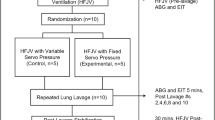Abstract
Lung function in eight infants with clinical and radiological features of surfactant defiency treated with exogenous porcine surfactant was studied before and at 15 min, 2h and 6h after the intratracheal administration of porcine surfactant. We measured alveolar-arterial oxygen tension difference, dynamic lung compliance, lung volume and effective pulmonary blood flow in all infants. The alveolar-arterial oxygen tension difference fell from a mean (SD) 43.3 (14.5) kPa before treatment to 8.8 (8.8) kPa at 1 h and 12.2 (6.8) kPa 6h after treatment (P<0.001). There was no change in mean (SD) dynamic compliance (0.39 [0.10] ml/cmH2O/kg pre dose; 0.36 [0.13] ml/cmH2O/kg 6h post treatment). Accessible functional residual capacity and effective pulmonary blood flow were measured using an adaptation of the argon/freon rebreathing method and showed an increase in mean (SD) functional residual capacity from 7.5 (1.4) ml/kg predose to 10.8 (3.3) ml/kg within 15 min of treatment, 11.4 (3.4) ml/kg 2h later and 12.7 (3.1) ml/kg 6h after treatment (P=0.009). Mean (SD) effective pulmonary blood flow values did not differ significantly, changing from 78.2 (20.9) ml/kg per min predose to 88.7 (24.1) ml/kg per min 15 min post dose, 87.6 (21.7) ml/kg per min 2h post dose and 90.0 (22.7) ml/kg per min 6h post dose (P=0.711).
Conclusion
The improvement in oxygenation after surfactant treatment is associated with an increase in lung volume but is not related to an improvement in dynamic lung compliance or effective pulmonary blood flow. The change in lung volume is detectable within 15 min of administration of the surfactant.
Similar content being viewed by others
Abbreviations
- A-aDO 2 :
-
alveolar arterial oxygen tension difference
- C dyn :
-
dynamic compliance
- FRC :
-
functional residual capacity
- Q p eff :
-
effective pulmonary blood flow
References
Altman DG (1991) Practical statistics for medical research. Chapman and Halt, London, pp 331
Bhat R, Dziedzic K, Bhutani V, Vidyasagar D (1990) Effect of single dose surfactant on pulmonary function. Crit Care Med 18:590–595
Bhutani VK, Sivieri EM, Abbasi S, Schaffer TH (1988) Evaluation of neonatal pulmonary mechanics and energetics: a two factor least mean square analysis. Pediatr Pulmonol 4:150–158
Bose C, Wood B, Bose G, Donlon D, Friedman M (1990) Pulmonary function following positive pressure ventilation initiated immediately after birth lation initiated immediately after birth in infants with respiratory distress syndrome. Pediatr Pulmonol 9:244–250
Bush A, Busst CM, Johnson S, Denison DM (1988) Rebreathing method for the simultaneous measurement of oxygen consumption and effective pulmonary blood flow during exercise. Thorax 43:268–275
Cotes JE (1975) Lung function. Blackwell Scientific Publications, Oxford, pp 202–204
Couser RJ, Ferrara TB, Ebert J, Hoekstra RE, Fangman JT (1990) Effects of exogenous surfactant therapy on dynamic compliance during mechanical breathing in preterm infants with hyaline membrane disease. J Pediatr 116:119–124
Edberg KE, Ekstrom-Jodal B, Hallman M, Hjalmarson O, Sandberg K, Silberberg A (1990) Immediate effects on lung function of instilled human surfactant in mechanically ventilated newborn infants with IRDS. Acta Paediatr Scand 79:750–755
Goldsmith LS, Greenspan JS, Rubenstein D, Wolfson MR, Schaffer TH (1991) Immediate improvement in lung volume after exogenous surfactant: Alveolar recruitment versus increased distension. J Pediatr 119:424–428
Halliday HL, McCord FB, McClure BG, Reid MMcC (1989) Acute effects of instillation of surfactant in severe respiratory distress syndrome. Arch Dis Child 64:13–16
Heneghan CPH, Branthwaite MA (1981) Non-invasive measurement of cardiac output during anaesthesia. Br J Anaesth 53:351–354
Ikegami M, Agata Y, Elkady T, Hallman M, Berry D, Jobe A (1987) Comparison of four surfactants: in vitro surface properties and responses of preterm lambs to treatment at birth. Pediatrics 79:38–46
Kelly E, Bryan H, Possmayer F, Frndova H, Bryan AC (1993) Compliance of the respiratory system in newborn infants pre- and postsurfactant replacement therapy. Pediatr Pulmonol 15:225–230
LeSouef PN, Lopes JM, England SJ, Bryan MH, Bryan AC (1983) Influence of chest wall distortion on esophageal pressure. J Appl Physiol 55:353–358
Morley CJ (1989) The use of artificial surfactant (ALEC) in the prophylaxis of neonatal respiratory distress syndrome. Eur Respir J 2:81–86
Morley CJ (1991) Surfactant therapy for premature babies — a review of clinical trials. Arch Dis Child 66:445–450
Sackner MA, Greeneltch D, Heiman MS, Epstein S, Atkins N (1975) Diffusing capacity, membrane diffusing capacity, capillary blood volume, pulmonary tissue volume and cardiac output measured by a rebreathing technique. Am Rev Respir Dis 111:157–165
Salt JC, Gothard JWW, Branthwaite MA (1980) Pulmonary blood flow and tissue volume. Anaesthesia 35:1054–1059
Tooley WH, Clements JA, Muramatsu K, Brown CL, Schlueter MA (1987) Lung function in prematurely delivered rabbits treated with a synthetic surfactant. Am Rev Respir Dis 136:651–656
Vilstrup C, Gommers D, Bos JAH, Lachmann B, Werner O, Larsson A (1992) Natural surfactant instilled in premature lambs increases lung volume and improves ventilation homogeneity within five minutes. Pediatr Res 32:595–599
Yee WFH, Scarpelli EM (1991) Surfactant replacement therapy. Pediatr Pulmonol 11:65–80
Author information
Authors and Affiliations
Rights and permissions
About this article
Cite this article
Alexander, J., Milner, A.D. Lung volume and pulmonary blood flow measurements following exogenous surfactant. Eur J Pediatr 154, 392–397 (1995). https://doi.org/10.1007/BF02072113
Received:
Accepted:
Issue Date:
DOI: https://doi.org/10.1007/BF02072113




